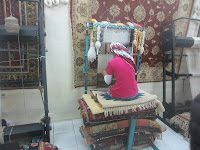
Perhaps one of the first places early man sought shelter was caves. When mankind evolved from hunter-gathers to permanent residents caves sometimes became residences. Not so long ago during our travels we visited a cave residence. Technically, referring to this house as a cave is a misnomer. According to definition a cave is created by natural forces, while these underground living spaces are constructed by men. There are people who have made living spaces out of caves in recent years in the name of unique dwellings. The cave dwelling we visited had been occupied constantly for many years. It had been passed down from generation to generation. In the Cappadocia area of central Turkey is the town of Goreme. Goreme has become a tourist destination for people visiting the caves of Cappadocia. The town sits on volcanic rock in the midst of rock pinnacles reaching skyward. Some of these pinnacles, conical stone fifty feet tall and taller, are called "fairy chimneys". They are also known as tent rocks, earth pyramids, and hoodoos and are pictured on a 50 Turkish lira note.
I've always found the people we meet on our travels interesting, and people in Goreme were no exception. Fortunately, there we had the had the opportunity to visit a person who lived in a cave dwelling as her home. The tour group we were a part of got off the bus overlooking a broad valley surrounded by rocky peaks of lava rock. In the valley were a hundred houses or more; some were conventional, and many were cave dwellings carved in huge fairy chimneys. From a small building selling souvenirs we walked down the stone steps to the entrance of the cave dwelling. This was the entrance to the cave house built in a low lying mound of solid stone. Once inside we walked down a passageway of about fifteen carved steps. The walls were void of any decoration. But there was electrical wire attached, spreading like a spider's web. The passageway divided at the entrance to the two rooms.

The first room was covered with hand knotted rugs of colorful and intricate designs, a kaleidoscope of textiles. The room was about 15 feet square with a window opposite the entrance. Visible through the window was a panoramic view of the valley below. The walls were reminiscent of stucco, but I believe they were whitewashed stone except where covered by what appeared to be brown kraft paper. There was a framed print of a woman at a loom on the wall amidst the electrical wiring. I thought this odd because because the Koran teaches that only God can create an image of a person. The furniture consisted of several low sofa,s also covered with hand-knotted carpets, and there were two low tables. On the right-hand side of the room was a doorway shrouded by a curtain. I glimpsed a refrigerator behind it. Illumination came from a single glaring fluorescent bulb from the low ceiling. The only other object in the room was a loom on the left-hand side. It was quite crude, having been assembled of local materials with hand tools. However, there was the beginning of a beautiful multicolored hand-knotted rug.
"This is Yade," Yesim, our tour guide said, "She welcomes us into her home."
"I am happy to see you," said the dark haired woman, who appeared to be about thirty-five years old, in English only slightly accented.
"She will be happy to answer any of your questions," our guide added
.
"How long have you lived here?" asked a Canadian lady.
"Since I married Hamid some fifteen years ago. The house has been in his family for generations."
"That is his shop at the top of the hill," added Yesim.
"He is a very good man. In my country the mother of the woman chooses the husband for her daughter," Yade told the surprised women in our group.
Yade was forthcoming with more information about her home and family. She said the there was an outside toilet, and that meals were prepared in the small kitchen. She had made one of the rugs on the floor as part of her dowry. It had taken two years to make.
"How do you heat this place? I know it sometimes snows in winter," asked our new friend John from Ottawa.
"We bring the coal-burning stove from the outside and put it there," she said, pointing to where the Indian doctor from Detroit was sitting.
Overhead the place for the stovepipe was clearly visible. Since in the Moslem world women are required to keep their heads covered, Yade gave the ladies some headgear tips. She demonstrated, using the women in our group as models, the various ways to wear a scarf covering one's head. However, there was a Pakistani lady who did not need her assistance as her head was already covered.
We visited for about an hour, including looking in the other room, which had cubbyholes carved into the rock for storage. She had a beautiful collection of folk dolls as well.
After saying our farewells to Yade we went to her husband's shop and had glasses of hot sweet tea while overlooking the valley below as the sun set in the west.









.JPG)

